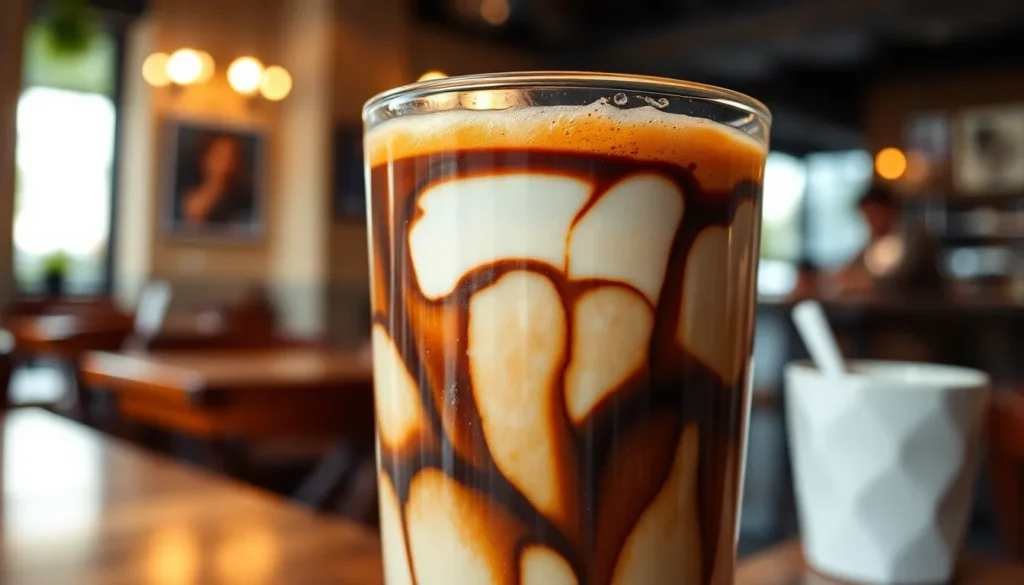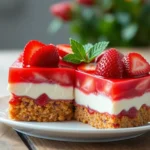We’ll bet you’ve never heard of dirty coffee – but once you try this trendy drink, you’ll wonder how you lived without it. This Instagram-worthy beverage originated in cafes across Asia and Australia, where baristas discovered the magic of layering cold milk with hot espresso to create a stunning visual contrast.
Dirty coffee isn’t actually dirty at all. The name comes from the “muddy” appearance when rich espresso slowly filters through creamy cold milk, creating beautiful marbled layers. It’s essentially a deconstructed latte that’s served without stirring, allowing each sip to deliver different flavor intensities.
What makes this drink special is its temperature contrast – the hot coffee warms your palate while the cold milk provides a refreshing finish. We’re obsessed with how simple ingredients can create such a sophisticated drinking experience. Ready to make your own viral-worthy dirty coffee at home?
What Is Dirty Coffee
Dirty coffee represents a contemporary twist on traditional espresso drinks that has captivated coffee enthusiasts worldwide. This innovative beverage combines hot espresso with cold milk in a way that creates distinct visual and flavor layers without mixing them together.
The drink gets its intriguing name from the marbled appearance that forms when hot espresso meets cold milk. We see beautiful swirls and patterns emerge as the espresso slowly penetrates the milk creating an artistic presentation that resembles abstract art in a glass.
Unlike conventional lattes or cappuccinos where ingredients blend completely dirty coffee maintains its layered structure throughout the drinking experience. Each sip delivers a unique combination of temperatures and flavors ranging from purely cold milk at the bottom to intensely hot espresso at the top.
The preparation method sets dirty coffee apart from other espresso beverages. We pour cold milk into a clear glass first then slowly add hot espresso shots on top allowing gravity to create the signature layered effect. This technique requires no stirring or mixing preserving the distinct boundaries between components.
Temperature contrast plays a crucial role in the dirty coffee experience. The cold milk provides a refreshing base while the hot espresso delivers warmth and intensity creating a sensory journey that changes with each sip. This unique characteristic makes dirty coffee an ideal choice for those seeking something beyond traditional hot or iced coffee options.
The drink originated in specialty coffee shops across Asia and Australia before gaining popularity in cafes worldwide. Baristas appreciate dirty coffee for its visual appeal and the skill required to achieve perfect layering while customers enjoy the interactive drinking experience it provides.
Equipment Needed
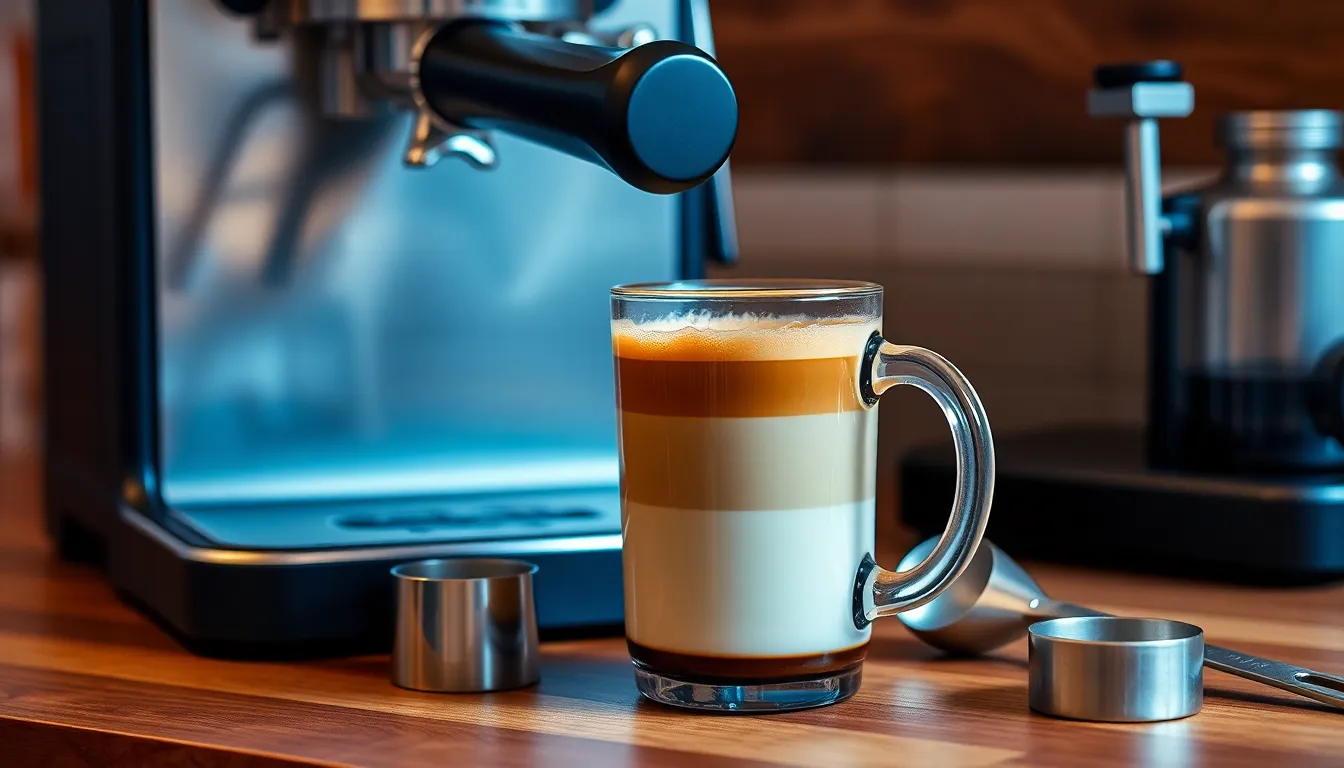
Creating the perfect dirty coffee requires exact tools that ensure proper layering and temperature contrast. We recommend gathering these essential items before starting your brewing process.
Essential Brewing Equipment:
- Clear glass or transparent mug (8-12 oz capacity)
- Espresso machine or stovetop espresso maker
- Measuring cup with pour spout
- Long-handled spoon (for gentle pouring technique)
- Digital thermometer
Additional Tools for Best Results:
- Milk frother or steam wand
- Coffee grinder (if using whole beans)
- Kitchen scale for precise measurements
- Timer for accurate extraction timing
The clear glass serves as our most critical tool since it showcases the beautiful layered effect that defines dirty coffee. Transparent containers allow us to monitor the milk and espresso separation while creating an Instagram-worthy presentation.
Your espresso machine becomes the heart of this operation. Whether using a traditional espresso machine or a stovetop maker, consistent pressure and temperature control ensure optimal extraction. We need equipment that can produce genuine espresso shots rather than regular coffee.
Measuring tools guarantee precise ratios between cold milk and hot espresso. A kitchen scale helps us maintain consistency across multiple servings while the thermometer ensures our milk stays properly chilled and our espresso reaches the ideal brewing temperature.
Equipment Maintenance Considerations:
| Equipment Type | Cleaning Frequency | Key Maintenance Points |
|---|---|---|
| Espresso Machine | Daily after use | Descaling monthly, clean group heads |
| Glass/Mug | After each use | Hand wash to prevent residue buildup |
| Measuring Tools | After each use | Rinse immediately to prevent milk proteins from setting |
Regular equipment maintenance prevents taste contamination that could affect our dirty coffee’s flavor profile. Clean brewing chambers and descaled machines produce the cleanest espresso shots essential for this layered beverage.
Ingredients
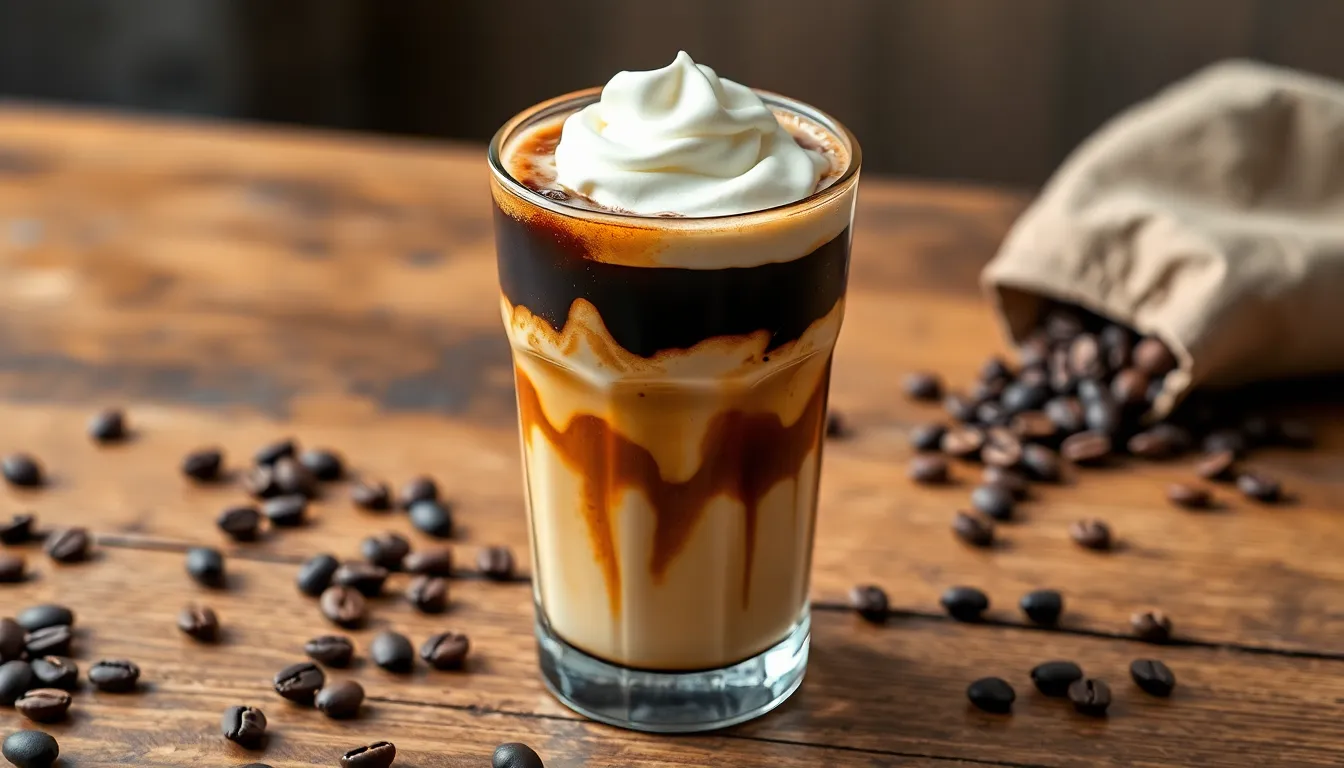
Creating the perfect dirty coffee requires just a few high-quality ingredients that work together to achieve the signature layered effect. We’ll break down each component to ensure you get the ideal balance of flavors and temperatures.
For the Cold Milk Base
The foundation of our dirty coffee starts with 130 g of chilled whole milk, which equals approximately 130 ml. We recommend using whole milk because its higher fat content creates a richer texture and provides better contrast against the bold espresso. The milk must be thoroughly chilled to maintain the temperature differential that makes this drink so distinctive.
Keep your milk refrigerated until ready to use, as the cold temperature is crucial for achieving the proper layering effect. Room temperature milk will not create the same visual impact or taste experience that defines authentic dirty coffee.
For the Hot Espresso
For the espresso component, we need 18 g of coffee beans to extract 45 g of finished espresso. The key here is brewing this as a ristretto shot, which produces a more concentrated and bolder flavor profile that stands up beautifully against the cold milk.
A ristretto extraction uses the same amount of coffee grounds as a regular espresso but with less water, resulting in approximately 1 to 2 ounces of intensely flavored coffee. This concentrated approach ensures our hot espresso maintains its distinct character when layered with the cold milk.
Optional Garnishes
While dirty coffee shines in its simplicity, we can enhance the experience with several optional additions. Whipped cream adds a luxurious texture and visual appeal when floated on top of the layered drink.
Half and half cream can be substituted for whole milk if you prefer a richer base, though this will alter the traditional flavor profile slightly. Vanilla syrup offers a subtle sweetness that complements the earthy espresso notes without overwhelming the drink’s natural complexity.
These garnishes allow for personal customization while maintaining the integrity of the original dirty coffee concept.
Instructions
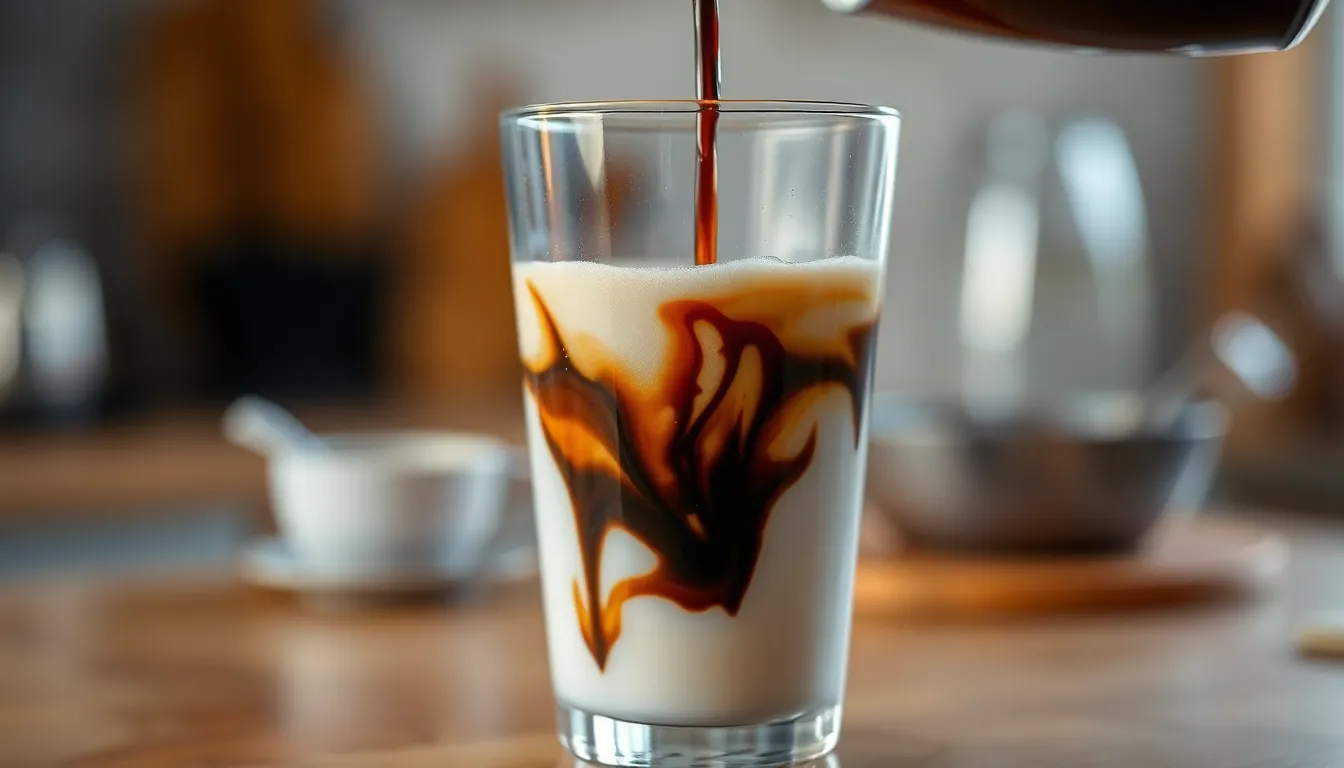
Creating the perfect dirty coffee requires careful attention to temperature contrast and layering technique. We’ll walk you through each step to achieve that signature marbled appearance and unique drinking experience.
Prep the Cold Milk
We start by chilling our whole milk to create the essential temperature contrast that defines dirty coffee. Pour 130 grams (about 4 to 5 ounces) of whole milk into your clear glass and refrigerate it until ice cold. The higher fat content in whole milk provides the rich texture needed for proper layering while maintaining the drink’s structural integrity.
Keep the milk in the refrigerator until you’re ready to assemble your dirty coffee. Cold milk serves as the foundation layer and creates the dramatic visual effect when hot espresso is added on top.
Prepare the Espresso
We recommend using 18 grams of medium to dark roast coffee beans for optimal flavor extraction. Grind the beans to an extra fine consistency to ensure proper brewing pressure and concentrated flavor development.
Set your espresso machine to pull a ristretto shot rather than a standard espresso. This concentrated brewing method uses the same amount of coffee but extracts only 1 to 2 ounces of liquid, creating a more intense flavor profile that stands up beautifully against the cold milk base.
The ristretto extraction technique originated from Bear Pond Espresso in Tokyo, where founder Katsuyuki Tanaka developed dirty coffee in response to customer feedback about traditional iced lattes.
Assemble the Dirty Coffee
Place your glass of chilled milk directly under the portafilter of your espresso machine. This positioning ensures the espresso flows directly onto the milk surface without disturbing the layering effect.
Pull the ristretto shot directly onto the cold milk surface without stirring or mixing. The hot espresso will naturally create beautiful marbled patterns as it interacts with the cold milk, forming the characteristic “dirty” appearance that gives this drink its name.
Resist the urge to stir the layers together. The beauty of dirty coffee lies in maintaining distinct temperature zones that create varying flavor experiences with each sip. Optional additions like vanilla syrup or half and half can be incorporated before adding the espresso if desired for extra sweetness or richness.
Directions for Perfect Layering
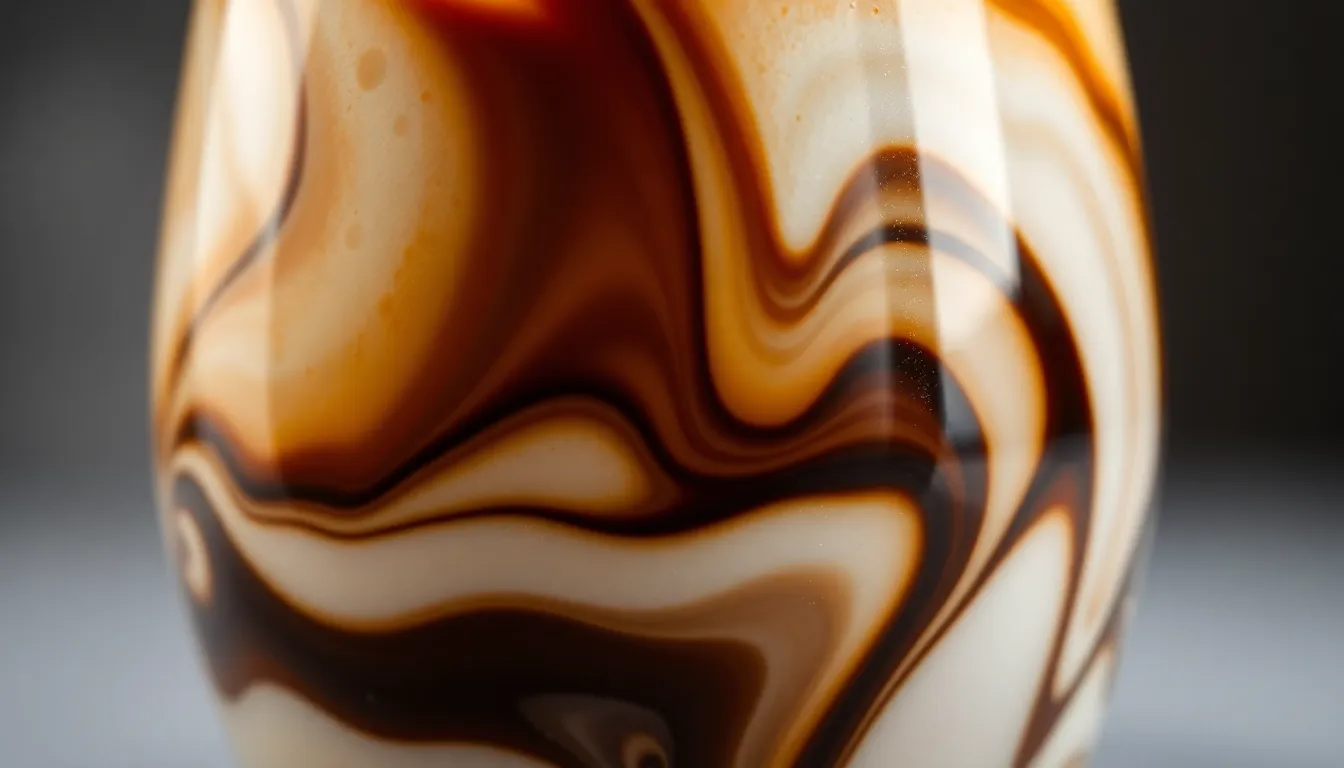
Achieving the perfect layered dirty coffee requires precise technique and attention to temperature differences. We’ll guide you through the essential steps to create those stunning visual layers that make this beverage so captivating.
Creating the Temperature Contrast
The foundation of dirty coffee lies in the dramatic temperature difference between our components. We need to chill our whole milk to the lowest possible temperature by placing it in the freezer for about 15 minutes before preparation. This extreme cold creates the thermal barrier necessary for proper layering.
Our espresso preparation focuses on pulling a concentrated ristretto shot using an 18 gram dose of coffee. We extract approximately 18 ml of espresso in about 20 seconds using a 1:1 coffee-to-water ratio. The resulting ristretto delivers intense flavor while maintaining the high temperature needed for the layering effect.
Temperature contrast serves as our primary tool for preventing immediate mixing. The hot espresso naturally wants to sit above the denser cold milk creating distinct thermal zones throughout the drink. We rely on this physical principle to maintain separation between our layers without any stirring or additional techniques.
Achieving the Visual Effect
Our pouring technique determines the success of the visual presentation. We pour the hot ristretto espresso gently over our chilled milk allowing it to cascade slowly through the cold base. The espresso creates beautiful marbling patterns as it trickles down through the milk.
Avoiding any stirring motion preserves the layered appearance that defines dirty coffee. We allow the natural density differences and temperature contrasts to create the signature visual appeal. The hot espresso gradually disperses through the cold milk creating those distinctive swirls and patterns.
The marbling effect develops as the espresso moves through different temperature zones in the milk. We observe how the coffee creates varying shades and textures throughout the glass producing an artistic presentation that changes with each sip. This visual transformation continues throughout the drinking experience making every moment unique.
Variations and Customizations
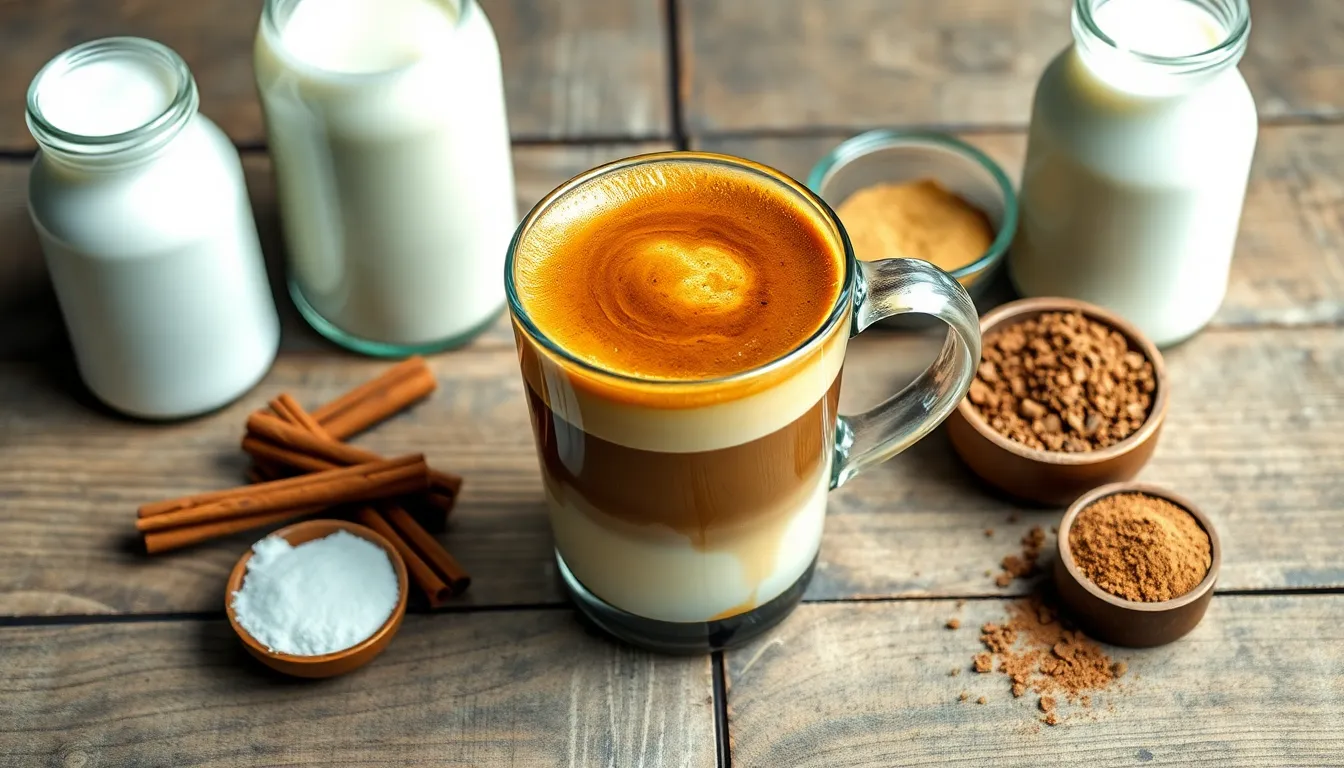
The beauty of dirty coffee lies in its adaptability to personal preferences and dietary needs. We can transform this layered beverage by experimenting with different milk types, flavor profiles, and sweetening options while maintaining its signature visual appeal.
Different Milk Options
Traditional dirty coffee relies on whole milk for its rich texture and optimal layering properties. The higher fat content in whole milk creates a substantial base that supports the hot espresso layer effectively. But, we can explore many alternatives to suit various dietary preferences and taste profiles.
Sweetened condensed milk offers an indulgent variation that adds natural sweetness while maintaining the drink’s creamy foundation. This option eliminates the need for additional sweeteners and creates an even richer texture than standard whole milk.
Heavy cream provides the ultimate luxurious experience with its thick consistency and high fat content. The cream creates an exceptionally stable base for the espresso layer while delivering a velvety mouthfeel throughout each sip.
Non-dairy alternatives expand accessibility for those with dietary restrictions or preferences. Soy milk delivers a smooth texture similar to dairy milk and maintains good layering properties. Almond milk offers a lighter option with subtle nutty undertones that complement the espresso’s bold flavors. Coconut milk brings tropical notes and natural sweetness while creating beautiful contrast patterns with the dark espresso.
Each milk alternative affects both the taste profile and visual presentation of the finished drink. We recommend testing different options to discover your preferred combination of flavor and texture.
Flavor Additions
While traditional dirty coffee celebrates the pure contrast between espresso and milk, we can incorporate additional flavors without compromising the drink’s integrity. The key lies in subtle enhancements that complement rather than overpower the coffee’s natural characteristics.
Vanilla extract or vanilla syrup adds warmth and sweetness that pairs naturally with espresso. A few drops mixed into the cold milk base create aromatic depth without disrupting the layering effect.
Cinnamon powder dusted lightly over the espresso layer introduces spice notes that enhance the coffee’s complexity. This addition works particularly well during cooler months when warming spices feel especially appealing.
Cocoa powder transforms dirty coffee into a mocha-inspired creation. Mixing a small amount into the milk base creates chocolate undertones that merge beautifully with the espresso layer.
Flavored syrups offer endless customization possibilities. Caramel syrup adds buttery sweetness, while hazelnut syrup brings nutty richness. We suggest starting with small amounts since the concentrated flavors can quickly overwhelm the delicate coffee and milk balance.
Sweetener Choices
The espresso’s natural bitterness in dirty coffee can benefit from thoughtful sweetening to achieve optimal flavor balance. We have several options that integrate seamlessly without disrupting the drink’s visual appeal.
Granulated sugar dissolves easily when mixed into the cold milk base before adding the espresso. This traditional approach provides clean sweetness without introducing additional flavors that might compete with the coffee.
Honey brings floral complexity and natural sweetness that enhances the espresso’s flavor profile. Mixing honey into the cold milk creates a smooth integration that develops throughout the drinking experience.
Simple syrup offers the most consistent sweetening solution since it blends effortlessly with cold liquids. We can prepare this ahead of time and adjust sweetness levels precisely for each serving.
Brown sugar syrup adds molasses notes that complement espresso’s roasted characteristics. This option provides deeper flavor complexity compared to regular sugar while maintaining the drink’s sophisticated profile.
The amount of sweetener depends on personal preference and the espresso’s intensity level. We recommend starting with minimal amounts and adjusting according to taste since the layered structure allows us to experience different sweetness levels throughout each sip.
Serving Suggestions
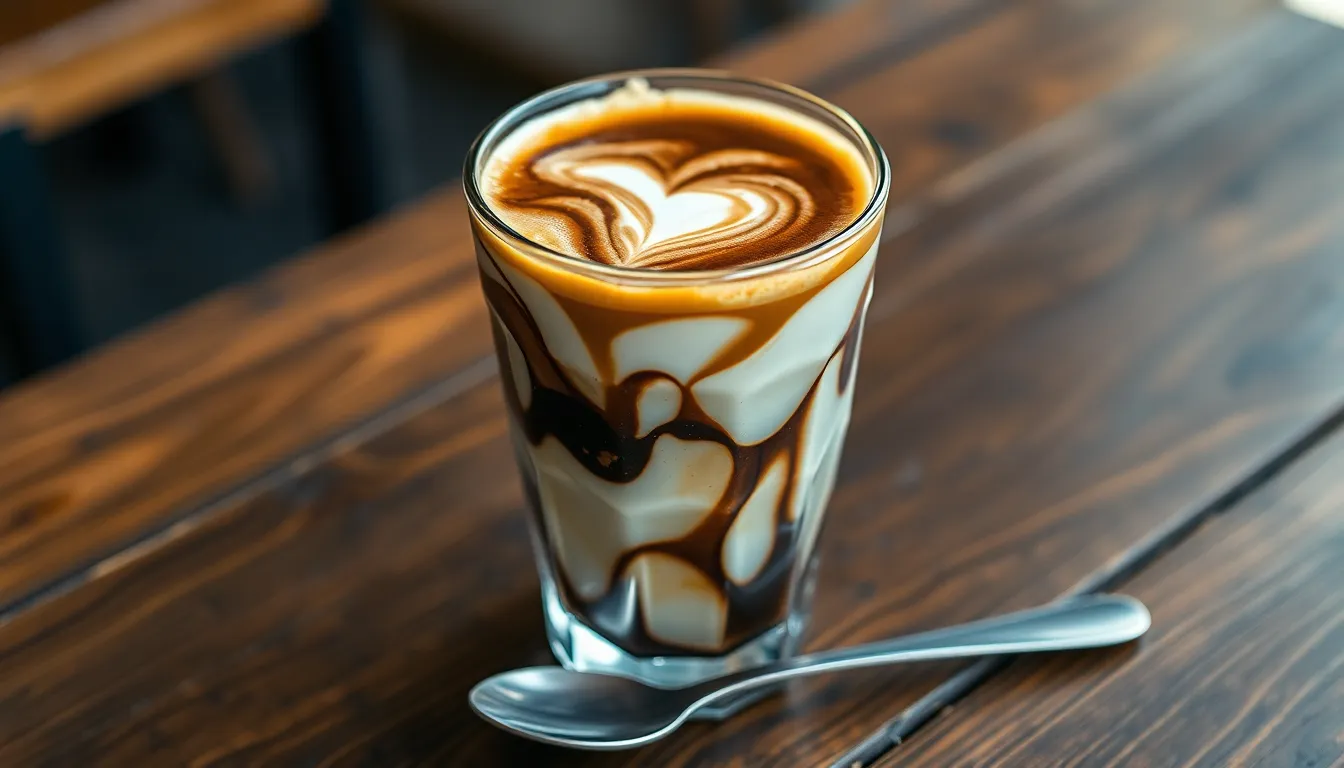
Proper presentation transforms dirty coffee from a simple beverage into an impressive café-style experience. We recommend using a clear glass to showcase the drink’s stunning layered appearance and allow guests to appreciate the marbling patterns that develop naturally.
Temperature Contrast Enhancement
Freezing your glass for 10-15 minutes before serving creates an enhanced temperature contrast that maintains the layered effect longer. The chilled glass prevents the cold milk from warming too quickly while preserving the hot espresso’s temperature at the top layer. This technique ensures each sip delivers the intended thermal experience that makes dirty coffee so distinctive.
Layering Technique for Visual Appeal
Achieving clean layers requires gentle handling and precise pouring methods. We suggest using a long-handled spoon to slowly drizzle the hot espresso over the back of the spoon onto the chilled milk surface. This technique minimizes turbulence and creates more defined boundaries between the temperature zones.
Position the spoon just above the milk surface and pour the espresso shot in a steady stream. The natural density differences between hot espresso and cold milk will create beautiful stratification without additional manipulation.
Serving Without Stirring
Dirty coffee should always be served without stirring to preserve its signature appearance and temperature experience. We recommend providing guests with a long spoon alongside the drink so they can control their own mixing preference. Some prefer to enjoy the distinct temperature layers as they drink while others may choose to partially blend the layers partway through.
The unstirred presentation allows drinkers to experience different flavor profiles with each sip as they progress from the cold milk base through the warm middle section to the hot espresso layer at the top.
Dark Roast Recommendations
Using dark roast coffee beans enhances the visual contrast and provides stronger flavor penetration through the cold milk layer. The robust flavor profile of dark roasts creates better definition between the espresso and milk components while offering more pronounced taste variations throughout the drinking experience.
We find that medium-dark to dark roast coffees work best for maintaining the drink’s intended flavor balance and visual impact.
Tips for Success
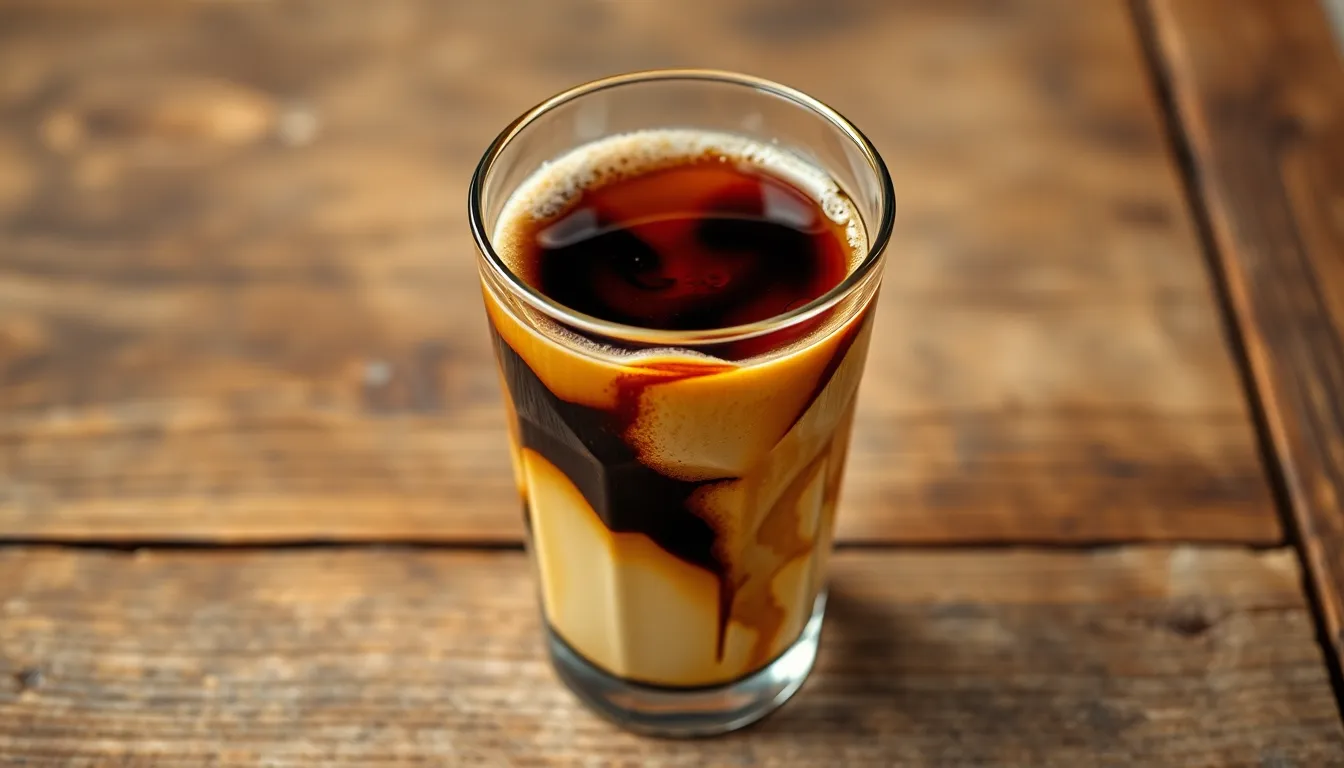
Mastering dirty coffee requires attention to exact details that separate exceptional results from ordinary attempts. We’ve gathered the most critical techniques to help you create this visually stunning beverage consistently.
Temperature Control
The foundation of perfect dirty coffee lies in achieving extreme temperature contrast between your components. We recommend chilling your milk to the lowest possible temperature by placing it in the freezer for exactly 15 minutes before preparation. This creates the thermal barrier essential for proper layering.
Your espresso must maintain its peak brewing temperature to create the necessary density difference. The hot espresso naturally wants to rise above the cold milk, but the extreme temperature differential allows it to float temporarily before gradually mixing. We suggest using a digital thermometer to monitor both components and ensure optimal contrast.
Glass temperature also plays a crucial role in maintaining the layered effect. Freeze your serving glass for 10-15 minutes before assembly to extend the visual presentation time and preserve the temperature gradient longer.
Timing Considerations
Speed becomes critical once you begin the layering process. We pull our ristretto espresso using a 1:1 coffee-to-water ratio with 18 grams of coffee, targeting an extraction time of approximately 20 seconds. This concentrated shot yields 18 ml of intensely flavored espresso perfect for dirty coffee.
The window between pulling your espresso and pouring it over the cold milk shouldn’t exceed 30 seconds. Espresso loses its optimal temperature and crema quickly, both essential elements for successful layering. We prepare all components beforehand to minimize delays during assembly.
Serve your dirty coffee immediately after preparation to capture the full visual impact. The layered effect gradually diminishes as temperatures equalize, so timing your service ensures guests experience the drink at its most impressive presentation.
Presentation Tips
Visual appeal drives the dirty coffee experience, making presentation techniques absolutely essential. We always use clear glass containers to showcase the dramatic layering effect between hot espresso and cold milk. The transparency allows observers to appreciate the marbled patterns as they develop.
Pour your espresso slowly and steadily over the cold milk surface, allowing it to cascade naturally through the temperature zones. We avoid any stirring motions that would disrupt the layered appearance. The espresso should sit on top initially before creating its signature marbling effect.
Quality espresso with thick, creamy crema provides the best suspension over cold milk. We ensure our espresso shots have sufficient body and richness to maintain their position temporarily before gradually integrating with the milk below. This creates the sophisticated visual appeal that defines exceptional dirty coffee.
Storage and Make-Ahead Instructions
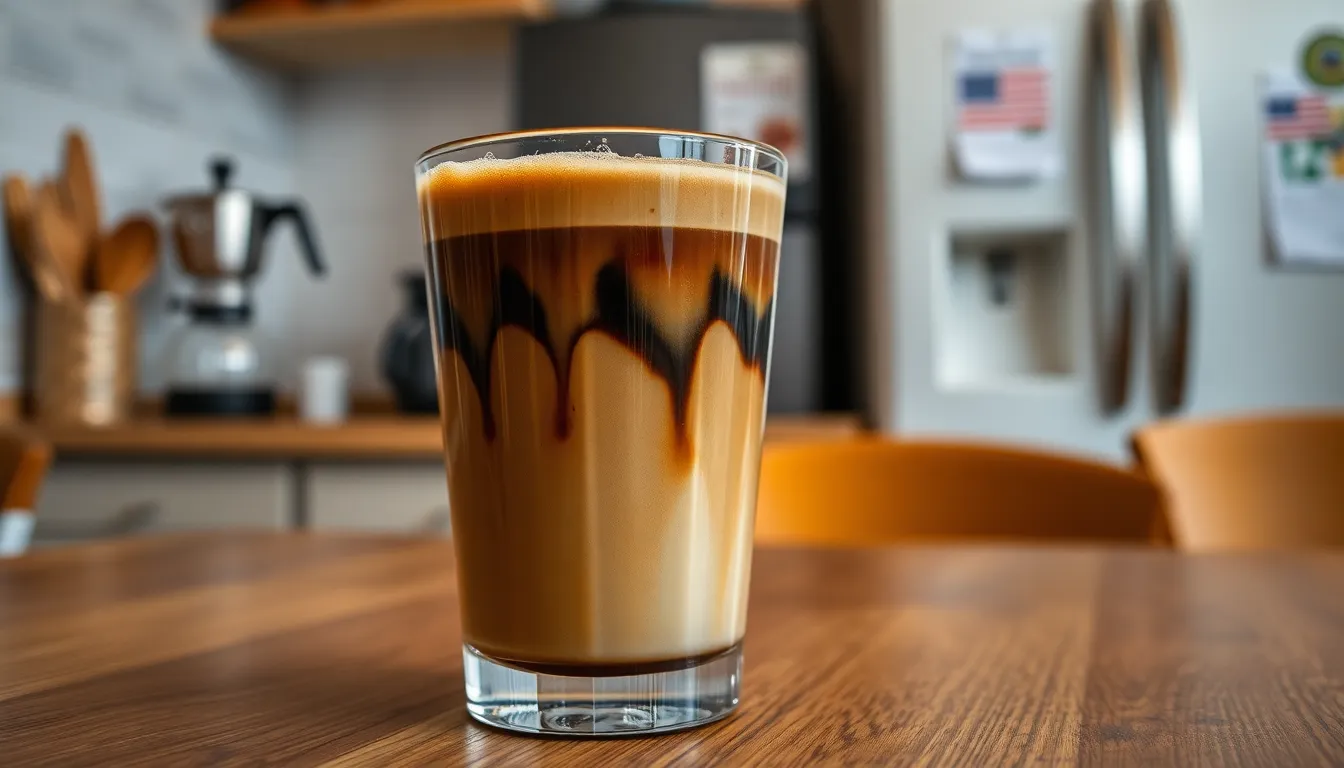
We understand that perfect timing is crucial for dirty coffee, so proper storage and preparation planning makes all the difference in achieving those stunning layers. The key to successful make ahead preparation lies in maintaining temperature control for both components.
Pre-Chilling Essentials
We recommend storing your clear glasses in the refrigerator for at least 2 hours before serving, or placing them in the freezer for 15-20 minutes for optimal results. This temperature differential creates the foundation for perfect layering and extends the visual appeal of your dirty coffee.
Whole milk should be chilled to its lowest possible temperature by keeping it in the coldest part of your refrigerator overnight. We suggest transferring the required amount to a measuring cup and placing it in the freezer for 10-15 minutes just before preparation to achieve maximum thermal contrast.
Component Preparation Timeline
Coffee beans can be ground up to 30 minutes before brewing to maintain optimal flavor freshness. We advise against grinding too far in advance as the oils begin to dissipate, affecting the espresso quality and crema formation essential for layering.
Espresso shots must be pulled fresh and used immediately after extraction. The temperature and crema density deteriorate rapidly, making advance preparation impossible for this component.
Storage Guidelines
Leftover dirty coffee loses its signature appearance within minutes due to temperature equalization. We do not recommend storing prepared drinks, as the layered effect cannot be preserved once the temperatures begin to merge.
Glass storage requires a cool, dry environment to prevent condensation that could affect the visual presentation. We suggest keeping chilled glasses covered with a clean cloth when stored in coolers to maintain their temperature without accumulating moisture.
Milk components can be pre-measured and stored in the refrigerator for up to 24 hours before use. This advance preparation streamlines the assembly process while maintaining ingredient quality and temperature integrity.
Conclusion
Dirty coffee offers us a refreshing departure from traditional espresso drinks with its stunning visual appeal and unique temperature contrasts. We’ve discovered that mastering this trendy beverage requires attention to detail in temperature control timing and presentation techniques.
The beauty of dirty coffee lies in its simplicity and customization potential. Whether we prefer classic whole milk or experiment with alternative options and flavor additions the drink adapts beautifully to our personal preferences while maintaining its signature layered appearance.
With the right equipment quality ingredients and proper technique we can easily recreate this café-quality experience at home. The key is remembering that dirty coffee is best enjoyed immediately after preparation when the temperature contrast and visual impact are at their peak.
Frequently Asked Questions
What is dirty coffee?
Dirty coffee is a trendy layered beverage that originated in Asian and Australian cafes. It’s made by combining cold milk with hot espresso without stirring, creating a visually appealing marbled effect. The “dirty” name refers to the artistic swirls and patterns formed when the hot espresso meets the cold milk, not its cleanliness.
How do you make dirty coffee at home?
To make dirty coffee, chill whole milk in the freezer for 15 minutes, then pour it into a clear glass. Pull a concentrated ristretto shot using 18g of coffee beans. Slowly pour the hot espresso over the cold milk using a long-handled spoon to create layers. Serve immediately without stirring.
Why is it called “dirty” coffee?
The term “dirty” refers to the drink’s appearance, not its hygiene. When hot espresso is poured over cold milk, it creates artistic swirls, marbling patterns, and layered effects that resemble “dirty” or murky water. This visual presentation is the signature characteristic that gives the beverage its unique name.
What equipment do I need to make dirty coffee?
Essential equipment includes a clear glass or transparent mug, an espresso machine, a measuring cup, a long-handled spoon, and a digital thermometer. The clear glass is crucial for showcasing the layered effect, while the espresso machine ensures proper extraction for the concentrated ristretto shot needed.
Can I customize dirty coffee with different ingredients?
Yes, dirty coffee is highly customizable. You can use different milk options like sweetened condensed milk, heavy cream, or non-dairy alternatives. Flavor additions include vanilla extract, cinnamon, cocoa powder, and flavored syrups. Sweeteners like honey, simple syrup, or brown sugar can balance the espresso’s bitterness.
What type of milk works best for dirty coffee?
Whole milk is recommended for dirty coffee due to its higher fat content, which creates a richer texture and better layering effect. The milk should be chilled to the lowest possible temperature to create the thermal barrier necessary for proper layering and visual contrast with the hot espresso.
How long does dirty coffee stay layered?
Dirty coffee should be served and consumed immediately after preparation to maintain its signature layered appearance. The layered effect gradually disappears as temperatures equalize, typically within 5-10 minutes. The drink cannot be stored while maintaining its visual appeal, making fresh preparation essential.
What’s the difference between dirty coffee and a regular latte?
Dirty coffee is essentially a deconstructed latte served without stirring. While a latte combines hot milk and espresso into one uniform temperature and flavor, dirty coffee maintains distinct temperature zones and flavors. Each sip offers varying experiences, from cold milk at the bottom to hot espresso at the top.

